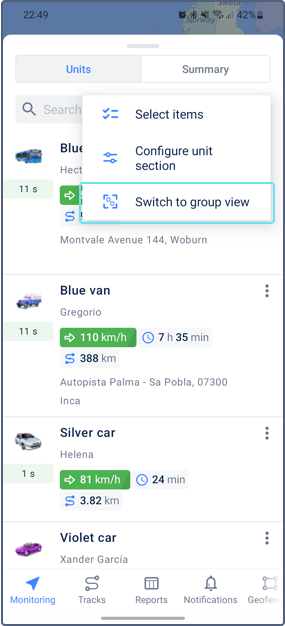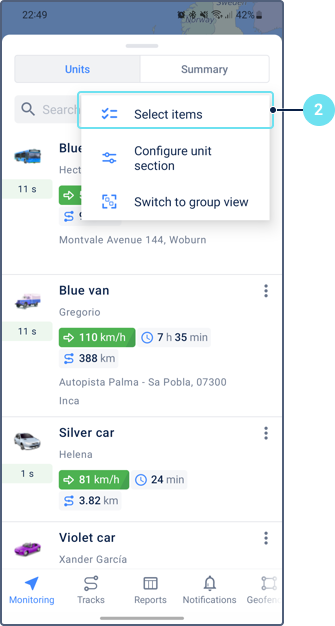Unit work list
For prerequisites, see the Monitoring page.
The work list displays the units that are being monitored. You can configure the way the available units are added to the work list. Only the units added to the work list can be tracked on the map, used for generating tracks, and included in the summary.
Units are created in the web version of Wialon and in CMS Manager. If the unit is deactivated, it is not displayed in the work list.
To access the unit work list, select the Monitoring tab in the navigation bar and open the Units tab.

Unit and unit group view modes
You can see units or unit groups in the work list. To switch between the modes, tap on the icon  and select Switch to group view or Switch to unit view.
and select Switch to group view or Switch to unit view.

In the unit view mode, you can see individual unit sections. They contain the latest data and a menu for performing actions with the unit: sending a command, sharing location, generating a report or a track, and more.
In the unit group view mode, you can see the names of the groups and the number of units belonging to them. Tap the line with the name of the group to see the list of units. Also, you can access the menu for performing actions with the unit group.

Work list generation modes
When you sign in to the application, units are automatically added to the work list if it was previously empty. If you have more than 100 units, add the required units yourself.
The content of unit and group work lists depends on the generation mode selected in the settings. To change this mode:
-
Tap the icon
 to the right of the search field.
to the right of the search field. -
Tap Select items.
-
In the configuration screen, choose one of the following modes:
Mode Description Show all The work list shows all units and unit groups if you have 20 units or fewer. If you have more, the units and groups are not added automatically. You should generate the work list manually. If this option is enabled and you have manually removed units from the list, the next time you sign in to the application, all units are shown again (if there are 20 or less).
Synchronize with the web version The list contains the same units and groups as the work list on the Monitoring tab of the web version. If this option is enabled, you can’t edit the list manually. Configure manually You add the units that should be displayed in the work list yourself. -
Tap the icon
 for saving the changes.
for saving the changes.
Adding items to the work list
You can add units or their groups to the work list if the Configure manually option is selected as a list generation mode.
To edit the work list, follow the steps below.
- Switch to the unit or group view mode, depending on what you want to add to the work list.
- Tap the icon
 located to the right of the search and tap Select items.
located to the right of the search and tap Select items.

- Select the required units or unit groups. When selecting, you can use the search or the Select all button to the right of it. In addition, you can use the Select all button to select all the items filtered by the search.

- Save the changes.
Removing items from the work list
You can remove units and their groups from the work list if the Configure manually option is selected as a list generation mode.
Use one of the following methods to remove a unit or group from the list:
- In the list, swipe left or right on the row of the item you want to remove.
- In the work list settings, similar to the process of adding items, cancel the selection of those items that shouldn’t be displayed in the list and save the changes.
As a result, the item is not shown in the work list, but it is not completely removed from the system.